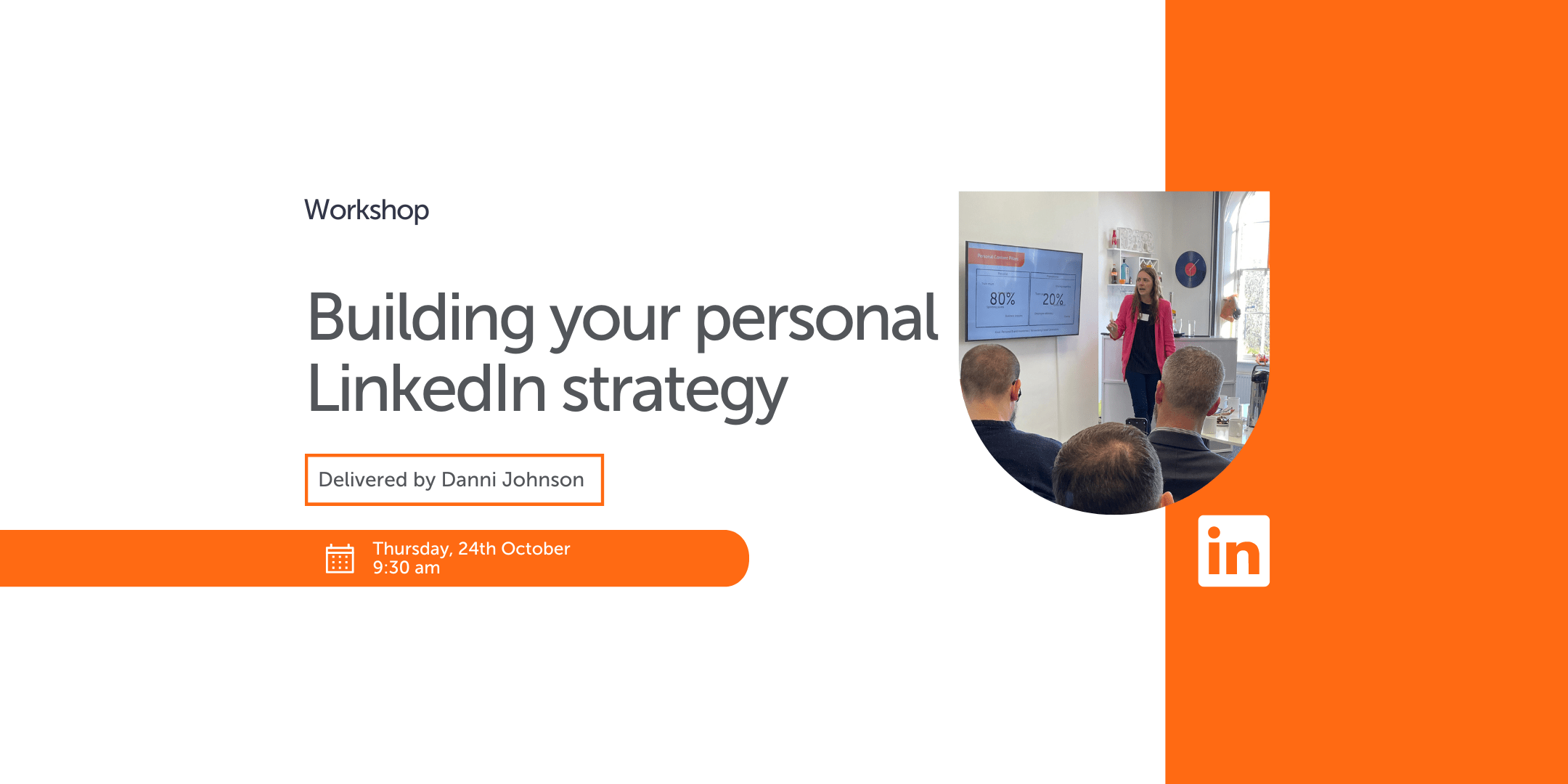Want to harness the power of a personal brand to grow your business? In April’s 80×20 learning slot, we shared how you can digitally connect your personal brand with your business brand.
Why 80×20?
80×20 is a series of events created by Xpand that allow you to learn about the latest in the digital marketing world while getting the chance to network with other business owners and marketing professionals.
In April we covered…
In April’s ‘20 minute mastery,’ the subject was – How to digitally connect your personal brand with your business brand.
‘Personal brand’ is a big buzzword at the moment. But it’s more than just a buzzword, it’s a very real thing and if you know how to harness it, you can make a real impact on your target audience.
‘People buy from people’ is the old saying, and that’s what personal brand is all about. In a B2B environment for SMEs, your clients are often buying from a real human, so ensuring your personal brand is present is paramount.
So, how can you connect your personal brand to your business brand?
Attendees learned:
- Where your personal brand should be prominent in the digital world.
- How to connect your personal brand to your business brand in the digital world.
- How to maximise interaction of your target audience with your business brand in the digital world.
- Evidence of how this has been achieved.
Video
Slides
What is a personal brand?
It’s a phrase that you’ve probably heard, more so in the last couple of years. It’s actually a topic that may have caused a lot of confusion, but we’re here to demystify it for you.
Our interpretation of personal brand is simply being who you are, and amplifying that through the channels where your target audience would be.
The channel we’ll be focussing on today is LinkedIn, due to the B2B arena we operate in, but the strategies can be used for any platform.
But let’s look at a more formal definition of personal brand, from none other than our good old friend Jeff Bezos:
“Your brand is what people say about you when you’re not in the room” – Jeff Bezos, founder of Amazon.
That’s a great definition because people can say whatever they want when you’re in front of them. What’s more powerful is what they say about you when you’re not there.
So what do you want your vibe, your values, and your beliefs to be? This all forms part of your personal brand, and ultimately what people say about you when you’re not in the room.
People buy from people
Have you ever heard the saying – ‘people buy from people’?
Whether you work as a solo freelancer or work as a bigger business, this forms part of your business brand.
However, when you’re out and about networking, sharing your expertise or even sharing non-business aspects of your life, that forms part of your personal brand. That’s where the connection is made between people and where the decision is made on whether someone would like to work with you or not.
When people become clients with Xpand, they’ve usually built a relationship with Jag or Danni over time.
On average you see between 3000 and 25,000 marketing messages in a day. You have to have seven touchpoints with a brand, and have a need or a want for it, only then you’re going to take action and make a purchase.
If you think about that in relation to yourself as an individual, the more your name is out there, the more you’re connecting with the people that are going to make that buying decision.
Simply put, people buy from people – and that’s what a personal brand is all about.
So let’s look at 3 ways to connect your personal brand to your business brand.
1. Tag your company’s LinkedIn page in personal LinkedIn posts
This may seem straightforward but it’s a powerful way to showcase your company page to people who may not know that you have one.
You can’t assume that whoever connects with you knows who you work for or what your brand is, people make lots of connections on LinkedIn every day.
So when you’re talking about your expertise, creating content or sharing insights, make sure to tag your company page where it makes sense. Obviously, there is a limit, so don’t overdo it.
Example:
Here’s an example post from our LinkedIn specialist Danni, where she shared a personal story and tagged Xpand in the post. As you can see it’s not been forced in, the story flows naturally and the mention is natural too.
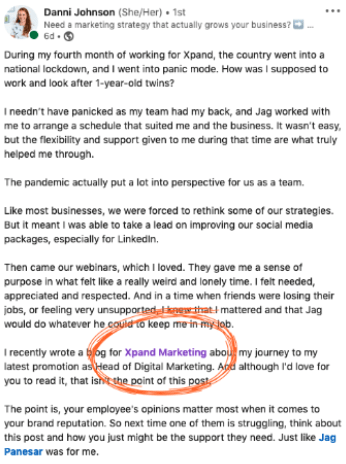
2. Make sure your LinkedIn profile is complete
You’d be amazed at the number of profiles we come across that are incomplete or not optimised for maximum impact.
LinkedIn is the only social media platform that will penalise you if all the sections are not filled in, it does this by reducing your reach. So it’s important that you fill in as many LinkedIn sections as possible. Below are a few examples of things you can include to make your personal brand stand out:
Example:
Include elements of your company branding in your cover photo:
You can see how Danni has included a picture of the team as well as some results she has achieved for our clients. You can also see that the cover image matches the Xpand branding, which helps people associate Danni’s personal brand with Xpand’s company brand.

Example:
Talk about your success in relation to your position in the business:
Danni has done some brilliant work for Mitchells, a client of ours, so you can see she has included that in her featured items. As well as some other items that showcase her expertise and results.
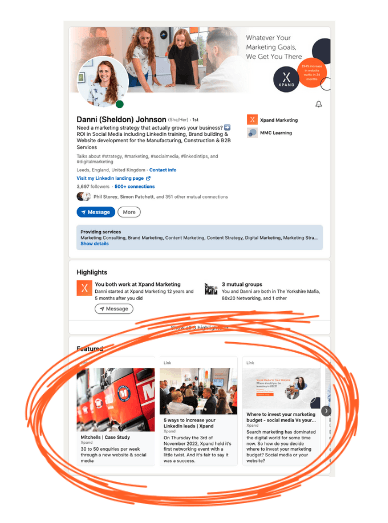
Ensure your experience section is complete:
This is the section that shows your past work experience and history. There are different sections within this that allow you to show your skills, any case studies or testimonials, and any results that you have achieved can be included in there.
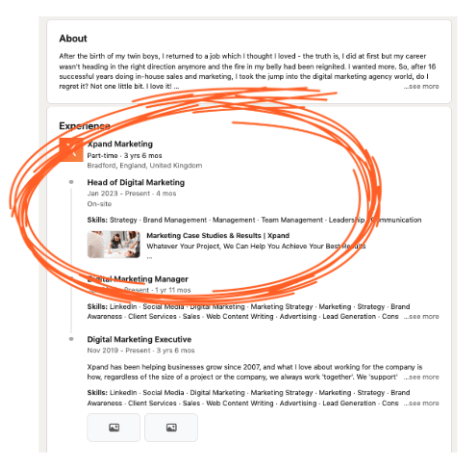
3. Create a LinkedIn landing page
This is something Jag created during the lockdown. As we all know face-to-face networking wasn’t a thing during lockdown so we had to look at creative ways to connect with people in the digital world.
That’s where the LinkedIn landing page came about.
During this time, Jag also did a poll on LinkedIn which gave some interesting results:

What does this mean?
You need to convert 24% of people into enquiries on their first website visit, this means the website needs to speak directly to its audience in an impactful way. You can learn how to do that in our recent blog post on how to prepare for your new website.
The poll also highlighted that there’s a risk of losing the other 76% to competition between website visits.
How can you keep more of your first-time visitors and simultaneously reduce the number of people you lose between visits to your website? A LinkedIn landing page can help.
When we implemented this strategy, we achieved:
- A 54% decrease in bounce rate (a bounce rate is when someone goes to your website, but then clicks off immediately)
- A 210% increase in pages viewed per session (this meant more people were navigating from the landing page to other pages on our website)
- A 1142% increase in average session time (meaning people were sticking around for longer than before)
As you can see, overall some great results!
So, how does the LinkedIn landing page strategy work? Let’s walk through it, using Danni, as an example….
Prior to the landing page strategy in place, when someone connects with Danni on LinkedIn, and after interacting with her content and posts a few times, they may be intrigued to get in touch and learn more about her, or Xpand.
At this point, they would click the ‘contact info’ link on her profile.

This would then lead to a pop-up with more information, where they could click on the Xpand website link to get to our homepage.
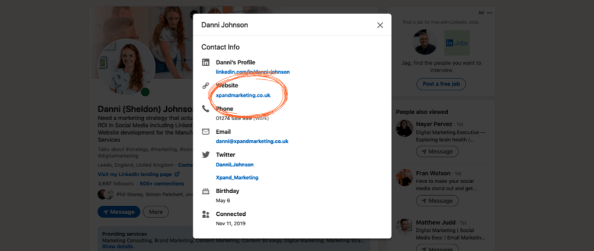
However, as our homepage is about Xpand not Danni, there’s a disconnect, which takes the user away from the information they want, causing them to potentially leave the website
Below you can see the traditional LinkedIn website link journey:
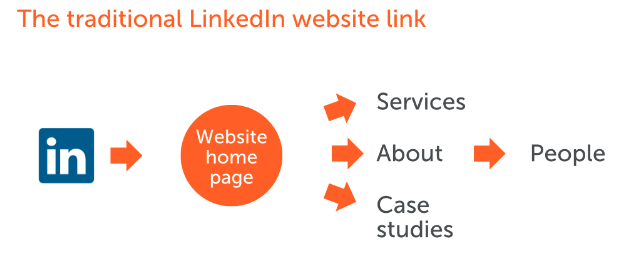
Alternatively, a LinkedIn landing page is a specific page that tells the person who clicks through, more about Danni.
It’s a natural progression from them reading and interacting with her content on LinkedIn, to then a dedicated page that tells them more about her, her expertise, projects she’s delivered results on and so forth.
It looks something like this:

The LinkedIn landing page strategy journey looks like this:
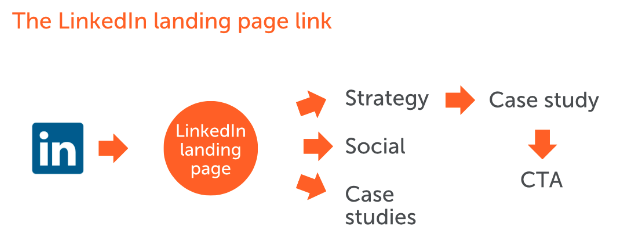
As you can see there’s a natural progression in the user journey in what they have seen on LinkedIn and now what they are seeing on our website. After which, they’re more likely to click on other pages or want to view our services etc.
In essence, a LinkedIn landing page allows you to create a bridge between your personal brand online and your business brand, which can allow you to deepen the relationship with your prospects and eventually turn them into happy clients.
If you want to dive deeper into the LinkedIn landing page strategy you can watch our webinar on how you can create a connection between your LinkedIn audience and your website.


